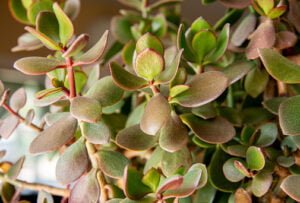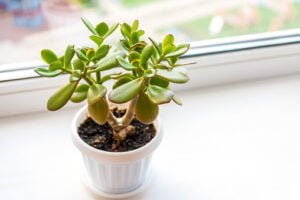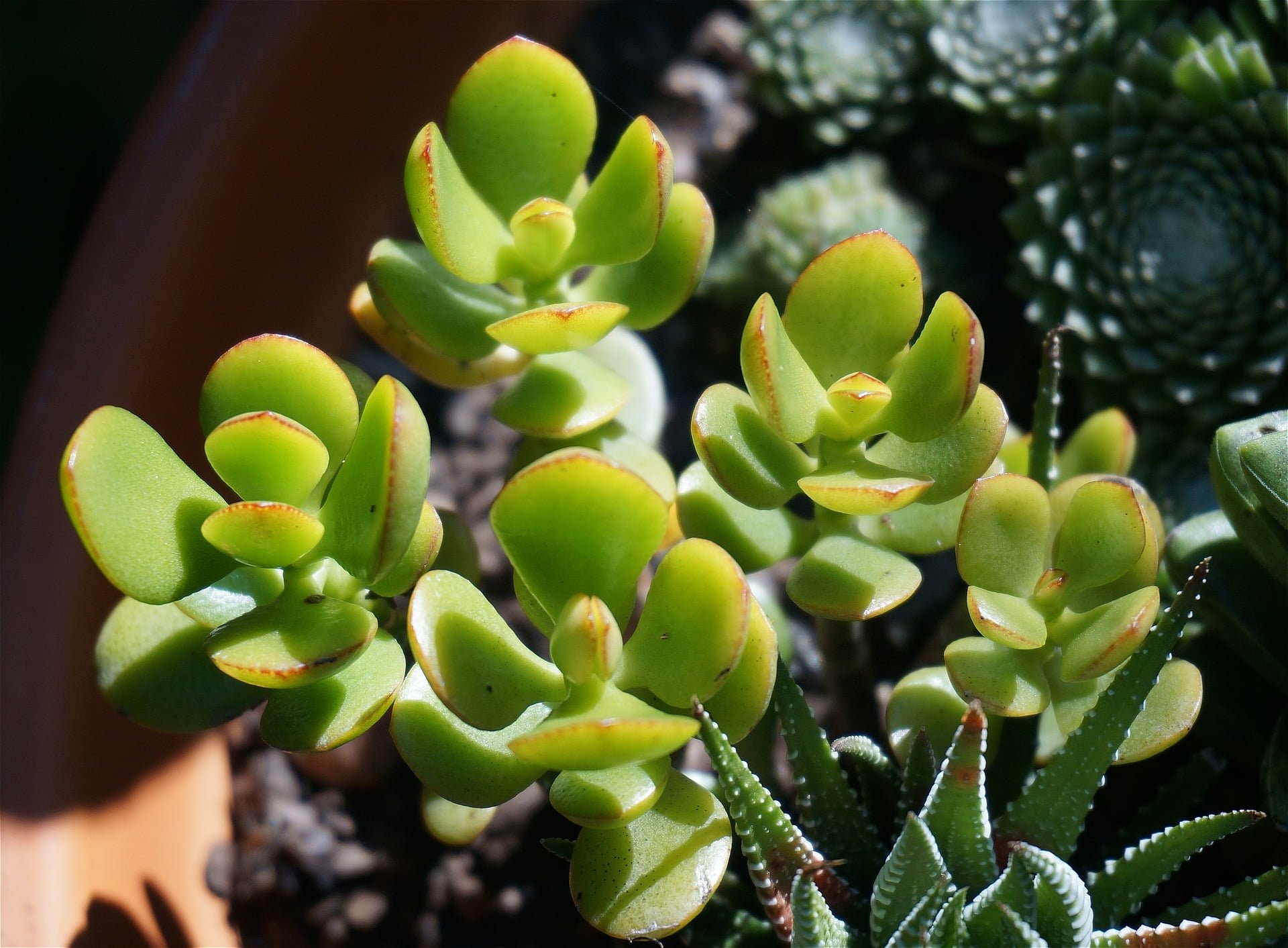Signs, symptoms, and solutions of overwatered jade plant
Too much water is a typical concern with Jade Plants (Crassula ovata). As a Jade Plant caretaker, it’s tempting to get carried away with the watering can. Overwatered jade plant symptoms and remedies are described in this article.
Toxic effects of overwatering on the Jade Plant include yellowing and dropping leaves, as well as soft and wilted foliage. Root rot and saturated soil are both common occurrences.
Overwatered Jade plants may be identified using the information provided below, as well as treatment options. I’ve published a comprehensive guide on jade plant care for more basic information.

Overwatered jade plant Symptoms
An overwatered jade plant display symptoms are similar to those of a plant that is drowned – namely, indications of dehydration. When you realize what happens to a Jade Plant when it gets too much water, it all makes sense.
Overwatered jade plant is unable to take in water and nutrients since it has lost its roots. As a result, even two seemingly unrelated issues with irrigation might have the same effect.
If you want to repair your Jade plant and avoid similar difficulties in the future, you must be able to distinguish the two issues apart. Each of the symptoms of Jade plant overwatering is described below.
Overwatered jade plants have yellowed leaves. The yellowing of a Jade plant’s leaves is one of the earliest symptoms of overwatering. If your plant has a lot of yellow leaves, though, something is wrong and has to be addressed. Sometimes, older leaves become yellow when new growth replaces them.
Overwaterd jade plants have yellowing of the leaves because the roots get wet and the plant is unable to absorb enough nutrients to prosper. If the leaves on your Jade Plant are turning yellow, now is the time to figure out what’s wrong and remedy it before it gets worse. Overwatering, underwatering, hot or low temperatures, pests, and disease may all produce yellow leaves. If this is the case, you’ll need to do further research before taking action to remedy the issue.
Overwatered jade plants may drop in the number of leaves on a plant. An overwatering issue might lead to leaf drop. Leaf drop occurs when the Jade Plant’s root structure weakens and is unable to sustain the leaves.
Overwatering isn’t necessarily to blame if your Jade plant loses older leaves as it ages. I don’t know whether it’s abnormal or not. Excessive or premature leaf drop is a symptom that there is too much water in the soil.
Overwatering Your Jade Plant Can Cause Soft Leaves. You’re most likely to assume that a plant needs more water if you compress the leaves of a Jade Plant and find them supple. This is not always the case, so don’t water it right away.
The thick, rigid leaves of a healthy Jade plant are packed with water. It’s possible that your Jade plant is being overwatered if the leaves are softer and more “squishy” than usual.
Root rot, induced by overwatering, is a common symptom of soft leaves on the Jade plant. Soft leaves, on the other hand, might be an indication of drowning or dehydration, so you might not be entirely incorrect. The roots and soil are the ideal places to look to see whether the leaves have become mushy as a result of either overwatering or underwatering.
Overwatering Your Jade Plant Can Result in Dry Leaves. It’s possible that your Jade Plant’s dry leaves are an indication that it’s dehydrated and needs watering. There may be a mistake in reaching for the watering can while thinking this way. Overwatered Jade Plants have non-functioning roots, which might cause the other symptoms of dry leaves.
Root Rot Caused by Wet Soil. This may seem apparent, but the quality of the soil in conjunction with the plant’s symptoms can assist you to determine the root cause of your plant’s issues. Root rot, which occurs when soil becomes too wet, may destroy your Jade Plant’s roots and prevent it from collecting water and nutrients. The plant gets dehydrated and displays indications of malnutrition when deprived of water and nutrients.
To determine the level of moisture in the soil, press your fingertips against it. You can rule out underwatering as a possibility if the soil and pot are wet and heavy with water. The roots of your plant should be examined if you notice that the soil is soaked and the plant seems to be unwell. Overwatering is most likely to blame if the roots are damp, squishy, and mushy.
How can you revive a jade plant that has been overwatered?
As soon as your Jade plant begins to exhibit indications of “illness,” you may fear that there is nothing you can do. As long as you act immediately, an overwatered Jade plant may be resurrected and restored to health.
The sooner you act to prevent your Jade plant from overwatering, the better off you will be. The following are a few suggestions:
Eliminate the Flooded Ground
Improving root conditions is the most crucial thing to do when dealing with a soggy Jade Plant. Remove the plant from the container and carefully remove the wet dirt from around the roots as much as you can. Remove the roots from the pot. After that, you’ll have to check the roots for health. There may be a need for drastic measures.
Remove The Rotting Roots That Affect The Most People
There is the potential for root rot to grow throughout a Jade plant’s root system and even into its stem. Pruning back the rotten roots of your Jade plant using sterile pruning scissors is a good idea. Cutting too much off isn’t an option. If the root is anticipated to survive, the interior should be completely white when you cut it. The root should be entirely white if you see some brown tint in the core.
You may then make another incision into each of the healthy roots to foster fresh root development and possibly assist the Jade plant bounce back once you’ve done this. To prevent the spread of disease, sanitize your pruners before use. Rub the blades with rubbing alcohol or put them in the flame for a few seconds to clean them.
Plant a New Pot
Repotting your Jade Plant into a new location will allow it to thrive better. Ensure that the container you choose is the correct size for the plant you want to house. It is ideal to choose a pot that is just big enough to accommodate the plant’s root system. The soil will dry out faster if you don’t use a big container.
Your Jade plant has to be re-potted with new, dry potting soil. Overwatering may be avoided if the soil is quickly draining. The greatest results will be achieved if you make your own soil mix. Potting soil, gritty sand, and perlite are all equal proportions in an excellent combination. Use cactus or succulent soil for convenience if you choose.

For a few days, you may stop watering the plants. It’s only necessary when the plant seems to be becoming a little spritely or when the roots and soil are fully depleted of moisture. Don’t go overboard when you begin watering the plant again.
When the earth is fully dry, water the Jade plant. Depending on the circumstances in your house, you may only need to do this every few weeks.
The Best Way to Avoid Overwatering Jade Plants
Symptoms of overwatered jade plant can be identified, diagnosed, treated, and revived, but it’s preferable to focus on prevention than treatment. In order to avoid any of the effects of overwatering on your Jade plant, the most effective strategy is to avoid it in the first place (or subject it to poor drainage conditions).
Before watering your Jade plant, make sure that the soil is dry enough and that extra water is needed. The soil may be tested with your finger, or the pot’s weight can be used to assess how dry the potting soil is, to see whether your houseplant needs watering.
The Best Ways to Make Your Jade Plant Happy
Make sure your Jade plant is in a happy and healthy environment before you do anything else. Potting, watering, and general upkeep are all part of this. In order to provide your Jade plant with the best possible living conditions, consider the following suggestions:
From the Get-Go, Make Sure You Pot Your Jade Plant Properly
If you take care of your Jade plant from the beginning, you won’t have to spend as much time and effort healing and reviving it later. It all begins with how you pot the plant in the first place.
The amount of water your Jade plant needs to deal with may be affected by the soil and container it is housed in. Because of poor drainage or waterlogged soil, your Jade plant will be forced to overwater.
Whenever you water your Jade plant, make sure the container has enough of drainage holes to prevent the soil from becoming clogged. Perlite may be added to the soil mix to improve drainage and prevent weeds.
Take Care Of Drip Tray Excess Water
Every time you water a Jade plant that has a drip tray, you may see that water drains from its pot and settles in the drip tray. If the soil is able to drain and the pot’s holes are not blocked, this is a positive sign.
In order to prevent the Jade plant from sitting in the saucer for a lengthy amount of time, it is vital to quickly remove any excess water from the saucer. Root rot may result as a result of this, as you would expect. Wait around 30 minutes after watering your succulent before removing the saucer.
Identify and Correct Overwatering Issues As They Occur
Overwatering your Jade plant once in a while won’t hurt it, but doing so on a regular basis might lead to difficulties. Stop what you’re doing and take a look at the issue. In light of the things we’ve mentioned in this article and in order to avoid your plant from suffering, make modifications.
Replacing a Badly Draining the Soil as Soon as Possible
A lack of excellent soil might be easily overlooked. Your Jade plant’s root system will suffer if your potting mix doesn’t drain properly. Jade Plants need to be re-potted if the soil isn’t draining.
Conclusion
Your favorite home plant may seem dead when you first notice the telltale indications of overwatering. Fortunately, there are many things you can do to revive your Jade plant and bring it back to full health again. An overwatered jade plant may never be an issue if you start your Jade plant in an optimum setting from the beginning.

[…] Overwatered Jade Plant Symptoms and Solutions […]